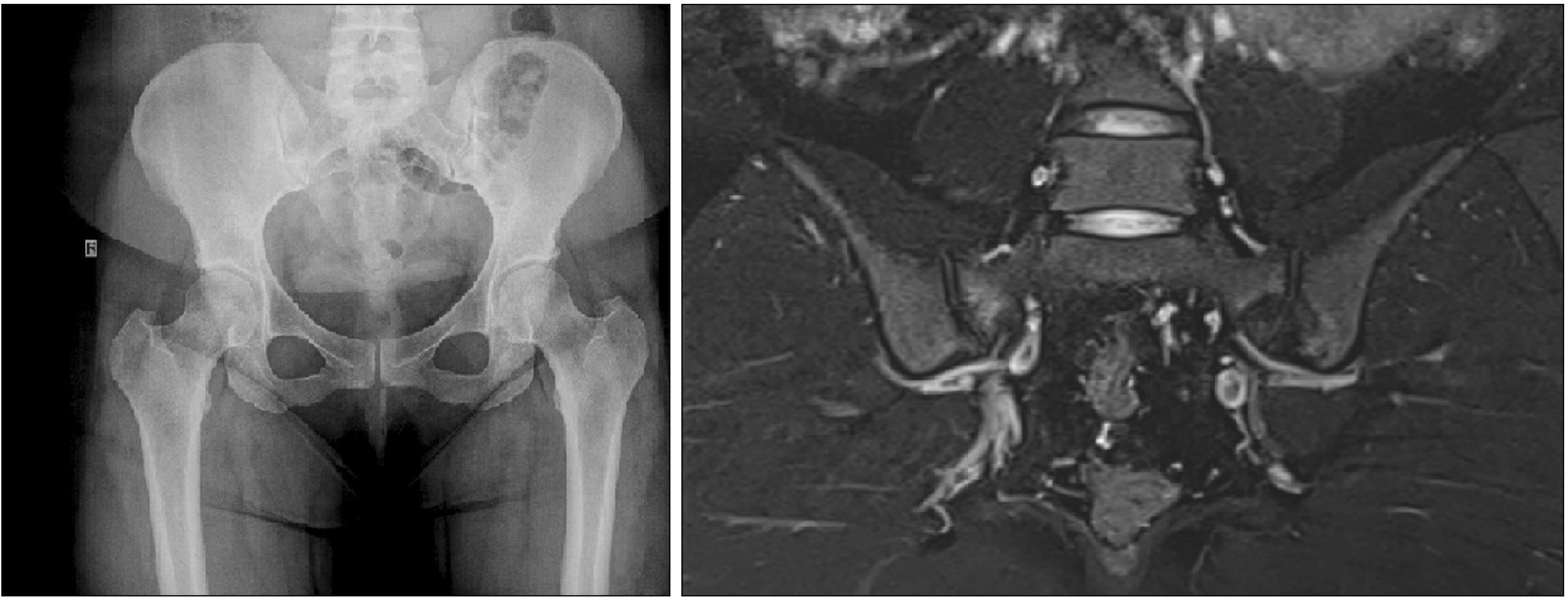J Rheum Dis.
2024 Apr;31(2):120-124. 10.4078/jrd.2023.0066.
Piriformis syndrome as an overlooked cause of pain in a patient with axial spondyloarthritis: a case report
- Affiliations
-
- 1Department of Physical Medicine and Rehabilitation, Cumra State Hospital, Konya, Turkey
- 2Division of Rheumatology, Department of Physical Medicine and Rehabilitation, Selcuk University Medical Faculty, Konya, Turkey
- 3Department of Physical Medicine and Rehabilitation, Selcuk University Medical Faculty, Konya, Turkey
- KMID: 2554361
- DOI: http://doi.org/10.4078/jrd.2023.0066
Abstract
- Piriformis syndrome is a neuromuscular disorder characterized by hip, buttock, and leg pain. Axial spondyloarthritis is a rheumatic disease primarily affecting the sacroiliac joint and the spine. Due to their anatomical proximity, the potential relationship between piriformis syndrome and sacroiliitis has been discussed for some time. However, literature review revealed that there is no study on piriformis syndrome in individuals with axial spondyloarthritis. Here, we present the case of a 30-year-old female with axial spondyloarthritis who developed severe low back, hip, and buttock pain that persisted despite initial treatment for axial spondyloarthritis. We first re-evaluated her condition through physical examination, magnetic resonance imaging, and an injection test for piriformis syndrome. Following a comprehensive assessment, the patient was diagnosed with both axial spondyloarthritis and piriformis syndrome. Subsequently, a tailored treatment plan was devised, addressing both conditions, and after a 3-month course of treatment, we obtained significant reduction in pain of the patient. This is the first case report in literature, where we used injection test to confirm the diagnosis of the piriformis syndrome in a patient with axial spondyloarthritis. We therefore strongly advocate considering piriformis syndrome as a potential etiology for pain in individuals with axial spondyloarthritis consistently. This recognition is important as piriformis syndrome does not respond adequately to non-steroidal antiinflammatory drugs and may lead to unnecessary use of biological disease-modifying antirheumatic drugs. Timely identification and intervention are imperative in ensuring optimal patient care.
Figure
Reference
-
1. Kirschner JS, Foye PM, Cole JL. 2009; Piriformis syndrome, diagnosis and treatment. Muscle Nerve. 40:10–8. DOI: 10.1002/mus.21318. PMID: 19466717.
Article2. Kean Chen C, Nizar AJ. 2013; Prevalence of piriformis syndrome in chronic low back pain patients. A clinical diagnosis with modified FAIR test. Pain Pract. 13:276–81. DOI: 10.1111/j.1533-2500.2012.00585.x. PMID: 22863240.
Article3. Scott DD, Anderson LC. 1994; The piriformis syndrome: a review. J Back Musculoskelet Rehabil. 4:248–54. DOI: 10.3233/BMR-1994-4314. PMID: 24572063.
Article4. Misirlioglu TO, Akgun K, Palamar D, Erden MG, Erbilir T. 2015; Piriformis syndrome: comparison of the effectiveness of local anesthetic and corticosteroid injections: a double-blinded, randomized controlled study. Pain Physician. 18:163–71. DOI: 10.36076/ppj/2015.18.163. PMID: 25794202.5. Yeoman W. 1928; THE relation of arthritis of the sacro-iliac joint to sciatica, with an analysis of 100 cases. Lancet. 212:1119–23. DOI: 10.1016/S0140-6736(00)84887-4.
Article6. Freiberg AH, Vinke TH. 1934; Sciatica and the sacro-iliac joint. J Bone Joint Surg. 16:126–36.7. Vassalou EE, Katonis P, Karantanas AH. 2018; Piriformis muscle syndrome: a cross-sectional imaging study in 116 patients and evaluation of therapeutic outcome. Eur Radiol. 28:447–58. DOI: 10.1007/s00330-017-4982-x. PMID: 28786005.
Article8. Sieper J, Poddubnyy D. 2017; Axial spondyloarthritis. Lancet. 390:73–84. DOI: 10.1016/S0140-6736(16)31591-4. PMID: 28110981.
Article9. Garrett S, Jenkinson T, Kennedy LG, Whitelock H, Gaisford P, Calin A. 1994; A new approach to defining disease status in ankylosing spondylitis: the Bath Ankylosing Spondylitis Disease Activity Index. J Rheumatol. 21:2286–91.10. Akkoc Y, Karatepe AG, Akar S, Kirazli Y, Akkoc N. 2005; A Turkish version of the Bath Ankylosing Spondylitis Disease Activity Index: reliability and validity. Rheumatol Int. 25:280–4. DOI: 10.1007/s00296-003-0432-y. PMID: 14730386.
Article11. Rudwaleit M, van der Heijde D, Landewé R, Listing J, Akkoc N, Brandt J, et al. 2009; The development of Assessment of SpondyloArthritis international Society classification criteria for axial spondyloarthritis (part II): validation and final selection. Ann Rheum Dis. 68:777–83. Erratum in: Ann Rheum Dis 2019;78:e59. DOI: 10.1136/ard.2009.108233corr1. PMID: 31088800.
Article12. Leong MK, Huang P. 2020; Piriformis syndrome as the only initial manifestation of septic sacroiliac osteomyelitis. Clin Med (Lond). 20:e18–9. DOI: 10.7861/clinmed.2020-0035. PMID: 32414734. PMCID: PMC7354056.
Article13. Phadke PS, Gandhi AR, More SA, Joshirao RP. 2017; Salmonella pyomyositis with concurrent sacroiliac osteomyelitis presenting as piriformis syndrome: a rare case. J Postgrad Med. 63:44–6. DOI: 10.4103/0022-3859.192799. PMID: 27779154. PMCID: PMC5394818.14. Kirkaldy-Willis WH, Hill RJ. 1979; A more precise diagnosis for low-back pain. Spine (Phila Pa 1976). 4:102–9. DOI: 10.1097/00007632-197903000-00003. PMID: 162546.
Article15. Papadopoulos EC, Khan SN. 2004; Piriformis syndrome and low back pain: a new classification and review of the literature. Orthop Clin North Am. 35:65–71. DOI: 10.1016/S0030-5898(03)00105-6. PMID: 15062719.
Article16. Bernard TN Jr, Kirkaldy-Willis WH. 1987; Recognizing specific characteristics of nonspecific low back pain. Clin Orthop Relat Res. (217):266–80. DOI: 10.1097/00003086-198704000-00029.
Article
- Full Text Links
- Actions
-
Cited
- CITED
-
- Close
- Share
- Similar articles
-
- Post-radiation Piriformis Syndrome in a Cervical Cancer Patient: A Case Report
- Piriformis syndrome: a case report
- Gait Improvement after Botulinum Toxin Injection in a Patient with Piriformis Muscle Syndrome
- Piriformis Syndrome: A Case Report
- Caudal Steroid Injection for Treatment of Piriformis Syndrome


